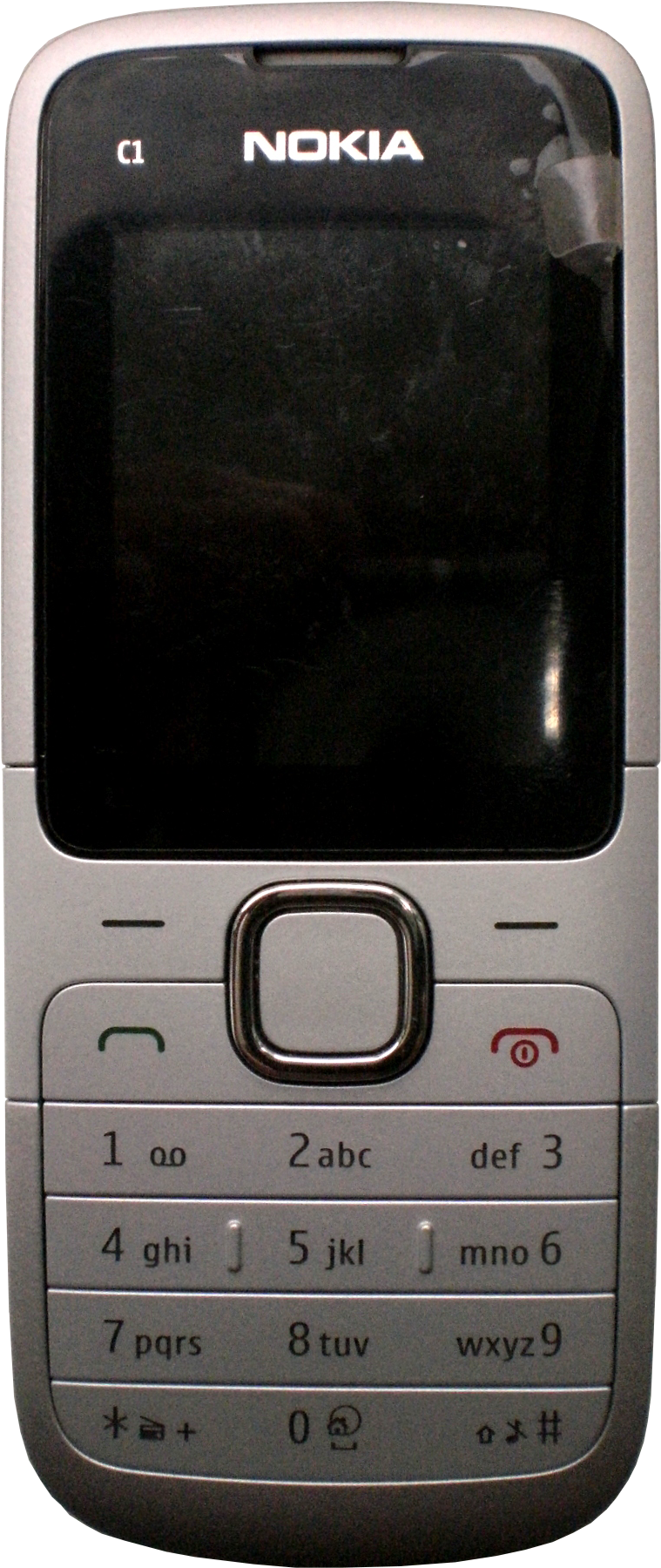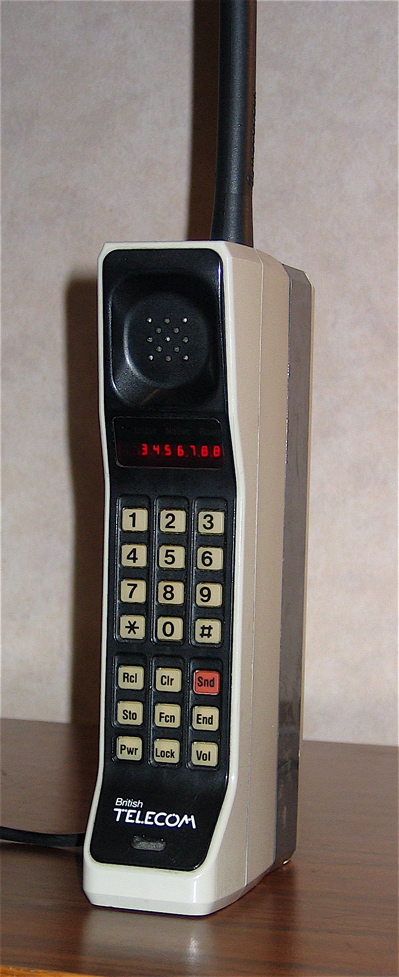|
Nokia 5110
The Nokia 5110 is a GSM mobile phone that was introduced by Nokia on 12 April 1998. The 5110, also known as Nokia 5146 on One2One (now T-Mobile), or the nk402 on Orange in the UK, was intended for the consumer market, succeeding Nokia 3110 and the analogue Nokia 232. Its design is based on the same platform as Nokia 6110 for the business market. It features a similar, simpler, revamped user interface called Series 20, but lacked the infrared data interface. It can, however, be interfaced with a computer via a cellular data card and a proprietary cable, enabling it to function like a modem to connect to remote computer systems through the Public switched telephone network (PSTN). The Nokia 5110 features an 84×48-pixel monochrome LCD with four LED backlights, operated by the Philips PCD8544 display controller. It is the first Nokia phone to come with replaceable faceplates, which Nokia branded "Xpress-on" covers; a concept Nokia incorporated into several other consumer-ori ... [...More Info...] [...Related Items...] OR: [Wikipedia] [Google] [Baidu] |
Nokia
Nokia Corporation (natively Nokia Oyj, referred to as Nokia) is a Finnish multinational telecommunications, information technology, and consumer electronics corporation, established in 1865. Nokia's main headquarters are in Espoo, Finland, in the greater Helsinki metropolitan area, but the company's actual roots are in the Tampere region of Pirkanmaa.HS: Nokian juuret ovat Tammerkosken rannalla (in Finnish) In 2020, Nokia employed approximately 92,000 people across over 100 countries, did business in more than 130 countries, and reported annual revenues of around €23 billion. Nokia is a public limited company listed on the [...More Info...] [...Related Items...] OR: [Wikipedia] [Google] [Baidu] |
Philips
Koninklijke Philips N.V. (), commonly shortened to Philips, is a Dutch multinational conglomerate corporation that was founded in Eindhoven in 1891. Since 1997, it has been mostly headquartered in Amsterdam, though the Benelux headquarters is still in Eindhoven. Philips was formerly one of the largest electronics companies in the world, but is currently focused on the area of health technology, having divested its other divisions. The company was founded in 1891 by Gerard Philips and his father Frederik, with their first products being light bulbs. It currently employs around 80,000 people across 100 countries. The company gained its royal honorary title (hence the ''Koninklijke'') in 1998 and dropped the "Electronics" in its name in 2013, due to its refocusing from consumer electronics to healthcare technology. Philips is organized into three main divisions: Personal Health (formerly Philips Consumer Electronics and Philips Domestic Appliances and Personal Care), Connecte ... [...More Info...] [...Related Items...] OR: [Wikipedia] [Google] [Baidu] |
List Of Acquisitions By Nokia
Nokia Corporation is a Finnish multinational communications corporation, founded in 1865. It is headquartered in Keilaniemi, Espoo, a city neighbouring Finland's capital Helsinki. Nokia is engaged in the manufacturing of mobile devices and in converging Internet and communications industries. Nokia was founded by Fredrik Idestam in 1865. The company was subsequently incorporated in the town of Nokia in 1871. The following is a list of acquisitions by Nokia since December 1997. During the past few years Nokia has been actively acquiring companies with new technologies and competencies, including also investments in minority positions. Since December 1997, Nokia has acquired 41 companies or businesses. The value of each acquisition is listed in either US dollars or Euros. If the value of an acquisition is not listed, then it is undisclosed. Acquisitions Divestments Since 1996, Nokia has made the following divestments. Notes References ;General * * ;Specific External ... [...More Info...] [...Related Items...] OR: [Wikipedia] [Google] [Baidu] |
List Of Nokia Products
The following is a list of products branded by Nokia. Current products and services Products by Nokia Technologies Wi-Fi routers * Nokia WiFi Beacon 1 * Nokia WiFi Beacon 3 Digital audio * Nokia OZO Audio Smart TVs Nokia markets smart TVs that run on Android TV. * Nokia Smart TV 55 inch * Nokia Smart TV 43 inch (to be launched on June 4, 2020) Products by Nokia Networks Nokia Networks is a multinational data networking and telecommunications equipment company headquartered in Espoo, Finland and wholly owned subsidiary of Nokia Corporation. The list of products is available hereNokia Networks - Solutions, Services & Products HMD Global products HMD Global develops devices under the ''Nokia'' brand. The company has signed a deal with Nokia allowing it to use the Nokia brand for its devices. Smartphones * Nokia 9 PureView * Nokia 8.3 5G * Nokia 8.1 (released in China as Nokia X7) * Nokia 8 Sirocco * Nokia 8 * Nokia 7.2 * Nokia X71 (available in Taiwan & China only) * ... [...More Info...] [...Related Items...] OR: [Wikipedia] [Google] [Baidu] |
IGB Eletrônica
IGB Eletrônica S.A. (Portuguese for ''IGB Electronics''), doing business as Gradiente, is a Brazilian consumer electronics company based in Manaus, and with offices in São Paulo. The company designs and markets many product lines, including video (e.g. televisions, DVD players), audio, home theater, high end acoustics, office and mobile stereo, wireless, mobile/smart phones, and tablets for the Brazilian market. History The company was founded in 1964. In 1993 they founded Playtronic, a fully owned subsidiary who licensed the manufacturing of Nintendo consoles in Brazil, and while publishing games for various systems they also provided Portuguese translations of some games (among them, '' South Park'' and '' Shadow Man'' for the Nintendo 64). However, they stopped the partnership with Nintendo in 2003 because of the high price of the dollar at the time. In 1997, Gradiente established a joint venture with Finland-based telecommunications manufacturing firm Nokia, where they we ... [...More Info...] [...Related Items...] OR: [Wikipedia] [Google] [Baidu] |
Advanced Mobile Phone System
Advanced Mobile Phone System (AMPS) was an analog mobile phone system standard originally developed by Bell Labs and later modified in a cooperative effort between Bell Labs and Motorola. It was officially introduced in the Americas on October 13, 1983,Private Line and was deployed in many other countries too, including Israel in 1986, Australia in 1987, Singapore in 1988, and Pakistan in 1990. It was the primary analog mobile phone system in North America (and other locales) through the 1980s and into the 2000s. As of February 18, 2008, carriers in the United States were no longer required to support AMPS and companies s ... [...More Info...] [...Related Items...] OR: [Wikipedia] [Google] [Baidu] |
IS-136
IS-54 and IS-136 are second-generation ( 2G) mobile phone systems, known as Digital AMPS (D-AMPS), and a further development of the North American 1G mobile system Advanced Mobile Phone System (AMPS). It was once prevalent throughout the Americas, particularly in the United States and Canada since the first commercial network was deployed in 1993. D-AMPS is considered end-of-life, and existing networks have mostly been replaced by GSM/GPRS or CDMA2000 technologies. This system is most often referred to as TDMA. That name is based on the abbreviation for time-division multiple access, a common multiple access technique which is used in most 2G standards, including GSM, as well as in IS-54 and IS-136. D-AMPS competed against GSM and systems based on code-division multiple access (CDMA). D-AMPS uses existing AMPS channels and allows for smooth transition between digital and analog systems in the same area. Capacity was increased over the preceding analog design by dividing eac ... [...More Info...] [...Related Items...] OR: [Wikipedia] [Google] [Baidu] |
Digital AMPS
IS-54 and IS-136 are second-generation ( 2G) mobile phone systems, known as Digital AMPS (D-AMPS), and a further development of the North American 1G mobile system Advanced Mobile Phone System (AMPS). It was once prevalent throughout the Americas, particularly in the United States and Canada since the first commercial network was deployed in 1993. D-AMPS is considered end-of-life, and existing networks have mostly been replaced by GSM/GPRS or CDMA2000 technologies. This system is most often referred to as TDMA. That name is based on the abbreviation for time-division multiple access, a common multiple access technique which is used in most 2G standards, including GSM, as well as in IS-54 and IS-136. D-AMPS competed against GSM and systems based on code-division multiple access (CDMA). D-AMPS uses existing AMPS channels and allows for smooth transition between digital and analog systems in the same area. Capacity was increased over the preceding analog design by dividing ea ... [...More Info...] [...Related Items...] OR: [Wikipedia] [Google] [Baidu] |
GSM-1900
GSM frequency bands or frequency ranges are the cellular frequencies designated by the ITU for the operation of GSM mobile phones and other mobile devices. Frequency bands GSM frequency usage around the world A dual-band 900/1800 device is required to be compatible with most networks apart from deployments in ITU Region 2. GSM-900, EGSM/EGSM-900 and GSM-1800 GSM-900 and GSM-1800 are used in most parts of the world (ITU-Regions 1 and 3): Africa, Europe, Middle East, Asia (apart from Japan and South Korea where GSM has never been introduced) and Oceania. In common GSM-900 is most widely used. Fewer operators use GSM-1800. Mobile Communication Services on Aircraft (MCA) uses GSM-1800. In some countries GSM-1800 is also referred to as "Digital Cellular System" (DCS). GSM-850 and GSM-1900 GSM-1900 and GSM-850 are used in most of North, South and Central America (ITU-Region 2). In North America, GSM operates on the primary mobile communication bands 850 MHz and ... [...More Info...] [...Related Items...] OR: [Wikipedia] [Google] [Baidu] |
GSM1800
GSM frequency bands or frequency ranges are the cellular frequencies designated by the ITU for the operation of GSM mobile phones and other mobile devices. Frequency bands GSM frequency usage around the world A dual-band 900/1800 device is required to be compatible with most networks apart from deployments in ITU Region 2. GSM-900, EGSM/EGSM-900 and GSM-1800 GSM-900 and GSM-1800 are used in most parts of the world (ITU-Regions 1 and 3): Africa, Europe, Middle East, Asia (apart from Japan and South Korea where GSM has never been introduced) and Oceania. In common GSM-900 is most widely used. Fewer operators use GSM-1800. Mobile Communication Services on Aircraft (MCA) uses GSM-1800. In some countries GSM-1800 is also referred to as "Digital Cellular System" (DCS). GSM-850 and GSM-1900 GSM-1900 and GSM-850 are used in most of North, South and Central America (ITU-Region 2). In North America, GSM operates on the primary mobile communication bands 850 MHz and ... [...More Info...] [...Related Items...] OR: [Wikipedia] [Google] [Baidu] |
GSM-900
GSM frequency bands or frequency ranges are the cellular frequencies designated by the ITU for the operation of GSM mobile phones and other mobile devices. Frequency bands GSM frequency usage around the world A dual-band 900/1800 device is required to be compatible with most networks apart from deployments in ITU Region 2. GSM-900, EGSM/EGSM-900 and GSM-1800 GSM-900 and GSM-1800 are used in most parts of the world (ITU-Regions 1 and 3): Africa, Europe, Middle East, Asia (apart from Japan and South Korea where GSM has never been introduced) and Oceania. In common GSM-900 is most widely used. Fewer operators use GSM-1800. Mobile Communication Services on Aircraft (MCA) uses GSM-1800. In some countries GSM-1800 is also referred to as "Digital Cellular System" (DCS). GSM-850 and GSM-1900 GSM-1900 and GSM-850 are used in most of North, South and Central America (ITU-Region 2). In North America, GSM operates on the primary mobile communication bands 850 MHz and ... [...More Info...] [...Related Items...] OR: [Wikipedia] [Google] [Baidu] |



